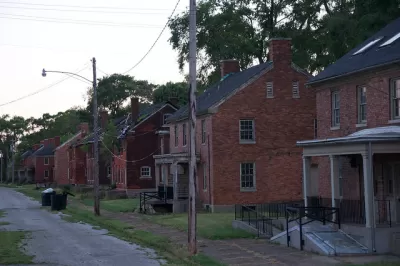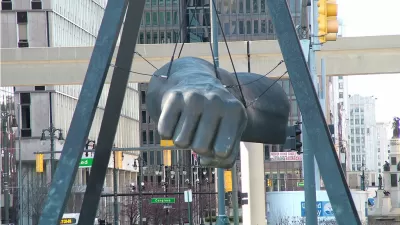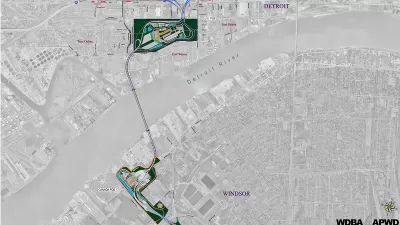A handful of Delray residents refuse to be displaced by industry, but the plan for a new bridge may mean they don't have a choice.

“Years ago, Delray was sentenced to die,” John Carlisle writes in a lengthy essay that amounts to a profile of this shrinking neighborhood in Detroit.
“In a city with plenty of rough neighborhoods, Delray is regarded as one of the worst. It’s been called Detroit’s backwater, its underbelly, the bowels of the region — which it literally is, in a sense, since the city’s wastewater treatment plant is here, receiving and incinerating the contents of everyone’s toilets in Detroit and 77 surrounding communities and filling the air for miles with a God-awful stink.”
The city has long hoped that residents will move away from Delray on their own, leaving an industrial zone, but in interviews with the handful of residents still living there, Carlisle finds deep ties to a place where members of the same family occupy neighboring houses.
Recent reports on Detroit have focused on the palpable, if uneven, recovery of the city, and Delray’s condition is, in a sense, the dark side of “rebirth,” as interest in emptying the neighborhood has become urgent.
“Now, the city is trying one more time to convince them to go. The long-planned new bridge to Canada, and the 170-acre customs plaza that will spread outward from the bridge’s footprint will wipe out much of the old neighborhood, splitting what’s left into two isolated pockets of semi-empty blocks. Those who choose to stay will be subject to a whole new level of noise and pollution. So the city is making an unprecedented offer to give residents another house someplace else in the city for free, plus a whole bunch of money to fix it up.”
Carlisle’s deeply reported piece looks at the history, geography, and demographics of a place that has both changed and stayed the same.
“Those left here say they feel under siege — by a city trying for years to get them to leave, by factories and industrial plants polluting their air, by criminals using their neighborhood to commit crimes in secret. But residents also speak of a bond in their shared isolation, a defiance toward those who look down on them as hayseeds, and a sense of anarchy and freedom that — for better or worse — can’t normally be found in a big city like Detroit.”
FULL STORY: Is this the end of Delray?

Alabama: Trump Terminates Settlements for Black Communities Harmed By Raw Sewage
Trump deemed the landmark civil rights agreement “illegal DEI and environmental justice policy.”

Planetizen Federal Action Tracker
A weekly monitor of how Trump’s orders and actions are impacting planners and planning in America.

The 120 Year Old Tiny Home Villages That Sheltered San Francisco’s Earthquake Refugees
More than a century ago, San Francisco mobilized to house thousands of residents displaced by the 1906 earthquake. Could their strategy offer a model for the present?

Ken Jennings Launches Transit Web Series
The Jeopardy champ wants you to ride public transit.

BLM To Rescind Public Lands Rule
The change will downgrade conservation, once again putting federal land at risk for mining and other extractive uses.

Indy Neighborhood Group Builds Temporary Multi-Use Path
Community members, aided in part by funding from the city, repurposed a vehicle lane to create a protected bike and pedestrian path for the summer season.
Urban Design for Planners 1: Software Tools
This six-course series explores essential urban design concepts using open source software and equips planners with the tools they need to participate fully in the urban design process.
Planning for Universal Design
Learn the tools for implementing Universal Design in planning regulations.
Clanton & Associates, Inc.
Jessamine County Fiscal Court
Institute for Housing and Urban Development Studies (IHS)
City of Grandview
Harvard GSD Executive Education
Toledo-Lucas County Plan Commissions
Salt Lake City
NYU Wagner Graduate School of Public Service





























